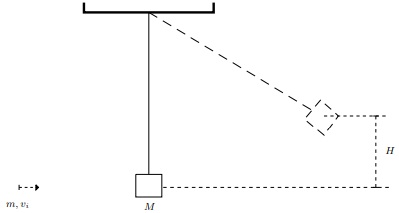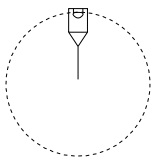Assignment:
Problem 1. Consider the ballistic pendulum setup shown below. A bullet of mass m = 0.02 kg and an initial speed of vi = 400 m/s collides with and embeds itself in a block of mass M = 5kg at the end of a massless rope that is initially at rest.
A) Find the speed of the bullet/block system just after the collision.
B) Find the maximum height H reached by the bullet block system.
C) Is the gravitational potential energy of the bullet/block system when it is at height H more than, less than, or equal to 1/2 m vi2. Explain.

Problem 2. A) Is more damage done to the colliding objects in an elastic or an inelastic collision. Explain.
B) In terms of impulse and momentum, why is it advantageous to follow through on a golf swing.
C) Is momentum conserved in all collisions? Explain.
D) Is kinetic energy conserved in all collisions? Explain.
Problem 3. Consider a collision between two objects each of mass 2 kg. Before the collision object 1 is moving eastward with a speed of 10 m/s and object 2 is moving westward with a speed of 4 m/s.
A) Find the velocities of the objects after the collision if the collision is completely inelastic.
B) Find the velocities of the objects after the collision if the collision is elastic
C) If after the collision object 1 moves to the left with a speed of 3 m/s, �nd the velocity of object 2 after the collision. How much kinetic energy was created or lost in this collision?
Problem 4. Consider an object with the position vector,
r→ = r sin (ωt) x^ + r cos (ωt) y^
A) Find the velocity vector. Express your answer in terms of x^ and y^.
B) What is the initial position of the object?
C) What is the initial velocity of the object?
D) Express the velocity vector in terms of r^ and/or θ^�.
E) Find the speed of the object.
F) Find the acceleration vector. Express your answer in terms of x^ and y^.
G) Express the acceleration vector in terms of r^ and/or θ�^.
H) Is this object undergoing uniform circular motion? Explain.
Problem 5. Consider a planet with no atmosphere, with a mass of 8.1024 kg and with a radius of 4 x 106 m.
A) What is the acceleration due to gravity near the surface of this planet?
B) What is the escape speed from this planet?
C) What would be the speed of a satellite in circular orbit of radius 6 x 106 m around this planet?
D) With what speed should a rocket be launched from the surface of this planet if the rocket is to reach a maximum height of 107 m above the surface of this planet?
Problem 6. A) Does an astronaut in orbit around the earth have more gravitational potential energy than does his twin on the earth's surface.
B) An astronaut weighs 600 N on the surface of the earth. What is the weight of the astronaut when she is in circular orbit of radius r = 4 RE. (RE is the radius of the earth.)
C) Why doesn't a satellite in circular orbit around the earth fall to earth?
Problem 7. A) A ball is whirled in a horizontal circle at the end of a string of length L = 0.5 m. Find the tension in the string and the angle that the string makes with the horizontal if the speed of the ball is 5 m/s. Take the mass of the ball to be 0.2 kg.
B) The coe�cient of static friction between a tire and a wet concrete track is 0.8. Find the maximum speed that a car could have if the car is to drive around a circular path of radius 50 m.
Problem 8. A person of mass 50 kg rides in a Ferris wheel of radius 20 m. The Ferris wheel completes a rotation once every 10 seconds. The motion of the Ferris wheel compartment is such that the person is always upright.
A) Find the normal force that the seat of the compartment exerts on the person at the top of the circular path traced out by the wheel.
B) Find the normal force that the seat of the compartment exerts on the person at the bottom of the circular path traced out by the wheel.
C) What would be the angular speed ! of the Ferris wheel if the person were to just lose contact with the seat at the top of the motion?
Problem 9. A) Why does an astronaut in orbit around the earth appear to be weightless?
B) A bug is placed in a cup which is whirled in a vertical circle. At the top of the circle (see the �Figure) the bug does not fall out of the cup. Why not?
C) Draw the unit vectors r^ and �θ^ at the position of the bug in the �gure above.

Problem 10. A) State the law of conservation of momentum.
B) Starting from the expression
F→net;external = dP→/dt
where P→ is the total momentum of a system of objects, prove the law of conservation of momentum.